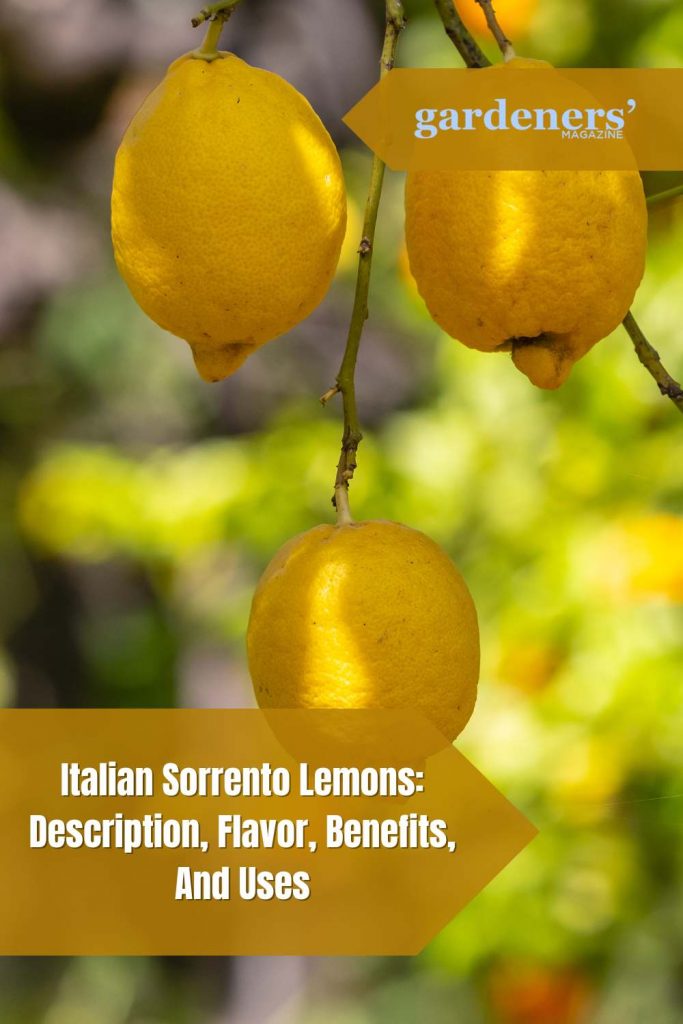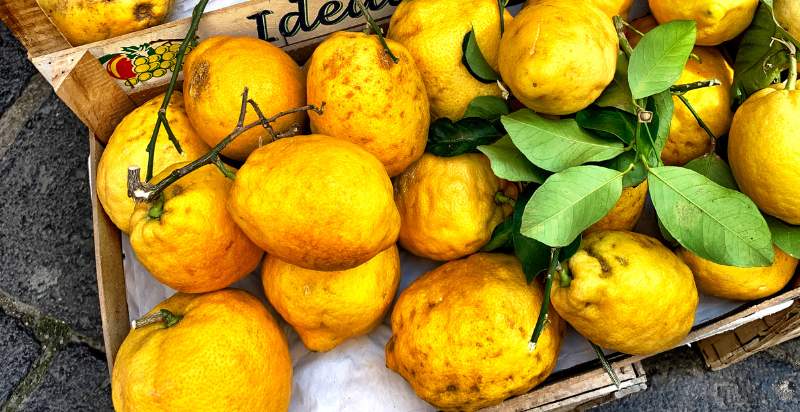Italian Sorrento lemons, also known as Sfusato Lemons, have been grown on Italy’s Amalfi Coast for centuries. These lemons are prized for their unique flavor, thick skin, and high juice content. They are harvested from May to October and can be found in grocery stores and specialty markets throughout the world. In this article, we will explore the history and characteristics of Italian Sorrento lemons and provide tips for selecting and using them.
What Are Italian Sorrento Lemons?
Italian Sorrento lemons are a variety of lemon native to the Amalfi Coast in Italy. They are also known as “Sfusato Lemons” due to their distinctive shape. The fruit is oblong and features a thick, bumpy skin that is usually a light green color when ripe. The flesh of the lemon is juicy and has a strong, tart flavor that is much more intense than other varieties of lemons.
They are also popularly used in many Italian recipes, such as limoncello and Sicilian lemon cake. The juice of these lemons is also quite tart and acidic, allowing it to be used as a flavor enhancer in many different dishes. Sorrento lemons are known for their high vitamin C content, making them a great addition to any healthy diet. They can be eaten raw or cooked, making a great garnish or accompaniment to many meals.

History and Origin of Italian Sorrento Lemons:
Italian Sorrento lemons, or Sfusato Amalfitano, originate from the Amalfi Coast in Italy. The area has a unique microclimate that is perfect for cultivating the fruit. These lemons are renowned for their bright yellow flesh and intense citrus aroma—their bulbous shape can identify them with few or no seeds.
The fruit’s popularity can be traced back to the 18th century when farmers began cultivating Sorrento lemons in the area. The Amalfi Coast’s acidic soil and mild climate, combined with its strategic location near the sea, make it ideal for growing this citrus variety. But despite their long history, Italian Sorrento lemons have only recently gained international recognition.
Today, these lemons are prized for their unique flavor and aroma. They have a higher sugar content than other varieties, making them perfect for cooking and baking. The zest is often used to add an intense freshness to dishes, while the juice can be used in marinades or as a flavoring agent. These lemons are also often used to make limoncello—a sweet, refreshing Italian liqueur.
No matter how you use it, one thing is certain: the Italian Sorrento variety can’t be beaten regarding lemons. Sweet and juicy with a unique aroma, these lemons are the perfect addition to any dish.
Description of the Italian Sorrento Lemons:
The Sorrento lemon is a prized variety of citrus fruit that grows in the Italian region of Campania. It is a large, juicy lemon with a thick yellow rind and fragrant aroma. The flesh is soft and aromatic, with an acidity-sweet balance that makes it ideal for cooking or cocktails. Its round to-oval shape measures approximately 5 to 8 cm (2 to 3 inches) in diameter. It has a bright yellow-green color and few seeds. The pulp is juicy, acidic, and flavorful, making it an excellent choice for many dishes.
Flavor Profile of the Italian Sorrento Lemons:
The flavor profile of the Italian Sorrento lemons is tart and slightly sweet. It has a distinct citrusy aroma with notes of lemon zest and green herbs. The taste is intense and fresh, balanced with sweetness and acidity. The flesh of these lemons is thin-skinned, making them great for juicing. They are also often used to add flavor and sweetness to salads, sauces, and other dishes.

Health Benefits of the Italian Sorrento Lemons:
As one of the most popular and highly sought-after lemons, Italian Sorrento lemons have several wonderful health benefits. The fruit has long been used in traditional Mediterranean cooking for its zesty flavor and unique aroma. Apart from their culinary uses, there are many advantages to consuming Sorrento lemons regularly.
The juice of Italian Sorrento lemons is packed with vitamin C, which helps boost the immune system and antioxidants that help protect against cell damage. It also contains powerful antibacterial and antiviral properties, which can help ward off infection.
The high levels of fiber in the lemons aid digestion, while their potassium content helps to regulate blood pressure and improve heart health. Regularly consuming this fruit can reduce inflammation, lower cholesterol, and even help lose weight.
Cultivation of the Italian Sorrento Lemons:
Culturing the Italian Sorrento lemon is a meticulous process requiring great attention to detail. The trees are planted in deep, well-drained soil and kept at an optimal height of 2.5 meters (8 feet). They must be pruned regularly to ensure a strong structure with lots of foliage. Fertilizers must also be carefully chosen for the best growth and yield. Additionally, keeping weeds away from the base is essential to avoid resource competition.
During flowering and fruiting, growers should also take great care in monitoring humidity levels and water availability to prevent diseases and pests. Finally, after harvesting, processing must be done quickly to maintain the best quality of the fruit. Considering all these considerations, it is no wonder that the Italian Sorrento lemon is renowned for its superior taste and quality.
Harvesting of the Italian Sorrento Lemons:
The Italian Sorrento lemon is essential to the region’s identity and economy. As such, it must be harvested with great care. The harvest season begins in May when the lemons turn green to yellow. During this time, local farmers carefully pick each lemon one by one using long-handled shears to ensure that no branches or leaves are damaged in the process. The harvested lemons are sorted into different grades, depending on their size and color, before being packaged and sent to market. Most of the lemon crop is sold within 48 hours of harvesting to ensure maximum freshness.
The Italian Sorrento lemon harvest continues until September when the lemons reach their peak maturity. At this stage, they have attained their signature sweet and tart flavor. During the harvest season, local farmers also look for any signs of disease or pests on the fruit to prevent its spread. This careful approach helps ensure that only the highest quality lemons make it to market.

Where Do Italian Sorrento Lemons Grow?
Italian Sorrento lemons are grown in Salerno especially; there are many large-scale producers of these specialty lemons. The coastal areas of Laz and Umbria are also home to a few lemon growers. Apart from these regions, Sorrento lemons can be found in the Val d’Orcia region of Tuscany and some parts of Abruzzo andioise. The Sorrento lemon is also grown in the Campania region of Italy, including the islands of Sicily and Sardinia. These lemons tend to be sweeter and have thinner skin than that of other types, making them ideal for cooking.
In addition to being used in food, these lemons are also used to make jams, liqueurs and as an ingredient in traditional recipes such as limoncello. With its pleasant, sweet-tart flavor and delicate aroma, the Sorrento lemon is a favorite among Italian cooks and food lovers alike.
What are the things you need to keep in mind when buying Italian Sorrento Lemons?
- Look for bright and firm lemons with smooth, glossy skin. Avoid lemons that are overly soft or have any blemishes, bruises, or discoloration.
- Smell the scent of the lemon to make sure it’s fresh-it should smell strongly and pleasantly of citrus.
- Select heavy lemons with thick skin; the thicker the skin, the juicier it is likely to be.
- Buy Italian Sorrento Lemons grown without pesticides or synthetic fertilizers whenever possible for healthier fruit that tastes better.
These are some of the things to consider when buying Italian Sorrento Lemons! Enjoy your tasty treat.
What are the places where the Best Quality Italian Sorrento Lemons can be brought?
The best quality Italian Sorrento Lemons can be purchased in Sorrento itself or online from various retailers. In Sorrento, they are sold in supermarkets and local specialty shops that specialize in selling citrus fruit. Online retailers include Amazon and eBay, where you can purchase larger quantities of Italian lemons at competitive prices.
Additionally, many import companies specialize in selling Italian Sorrento Lemons both domestically and abroad. You can also visit farmers’ markets or local grocers for fresh, seasonal lemons from Sorrento. No matter what option you choose, buy your lemons from a reputable source to ensure the best quality.
What is the Best Way to Store Italian Sorrento Lemons?
The best way to store Italian Sorrento Lemons is in a cool, dark, and dry place. Using an air-tight container is important to ensure the lemons do not absorb any moisture or odors from other foods stored nearby. If you have extra space in your refrigerator, storing them there for up to two weeks is advisable. Otherwise, please keep them in a cool place like your pantry or cupboard.
It’s also important to keep the lemons away from direct sunlight as this could cause them to ripen too quickly. If you are not using the Italian Sorrento Lemons within two weeks of purchasing, it is best to freeze them for longer storage. When freezing, package the lemons in an air-tight container and use them within one month of freezing.
If you’d like to extend the shelf life of your Italian Sorrento Lemons even longer, it’s best to preserve them through a pickling process. To do this, fill a jar with enough vinegar or brine to cover the lemons and store them in your refrigerator. This will give you up to a month’s worth of use with your Italian Sorrento Lemons.
How to use Italian Sorrento Lemons in Recipes with others?
Italian Sorrento lemons are incredibly versatile and can be used in many recipes. They work perfectly with other flavors and ingredients to create a delicious dish. Here are some ways to incorporate Italian Sorrento lemon into your meals:
- Add freshly squeezed Italian Sorrento lemon juice to grilled meats or fish marinades. Combining the acidity from the lemon and the savory herbs will give your meal an extra zing.
- Create a light vinaigrette with olive oil, Italian Sorrento Lemon juice, and your favorite herbs like oregano, basil, rosemary, or thyme for an added flavor punch. Use it as a salad dressing or drizzle it over roasted vegetables.
- Infuse Italian Sorrento lemon slices into simple syrups for cocktails or mocktails. The light and citrusy flavor pairs perfectly with mint, ginger, and cranberry flavors.
- ix up your desserts using Italian Sorrento lemons as zest or juice. Add it to a classic pound cake recipe to give it a refreshingly tart note, or add freshly squeezed juice to creamy custards for an unforgettable finish.
These are just some ideas for incorporating Italian Sorrento Lemons into your recipes. Get creative and experiment with different combinations to make unique dishes everyone loves.
Conclusion:
With their bright, tart flavor and versatile uses in cooking and baking, Italian Sorrento Lemons are a must-have ingredient for any home cook. Whether you use them to add zing to salads or enhance the flavor of your favorite desserts, these lemons will take your recipes up a notch. Don’t forget the proper storage tips; this way, you can save time and energy while still enjoying delicious Italian Sorrento lemons all year round!
- Everything You Wanted to Know About Red Tamarillos - June 2, 2025
- A Guide to Tulips: Everything You Need to Know & More… - June 2, 2025
- Guanabana: Description, Flavor, Benefits, And Uses - May 27, 2025

3 thoughts on “Italian Sorrento Lemons: Description, Flavor, Benefits, And Uses”
Comments are closed.